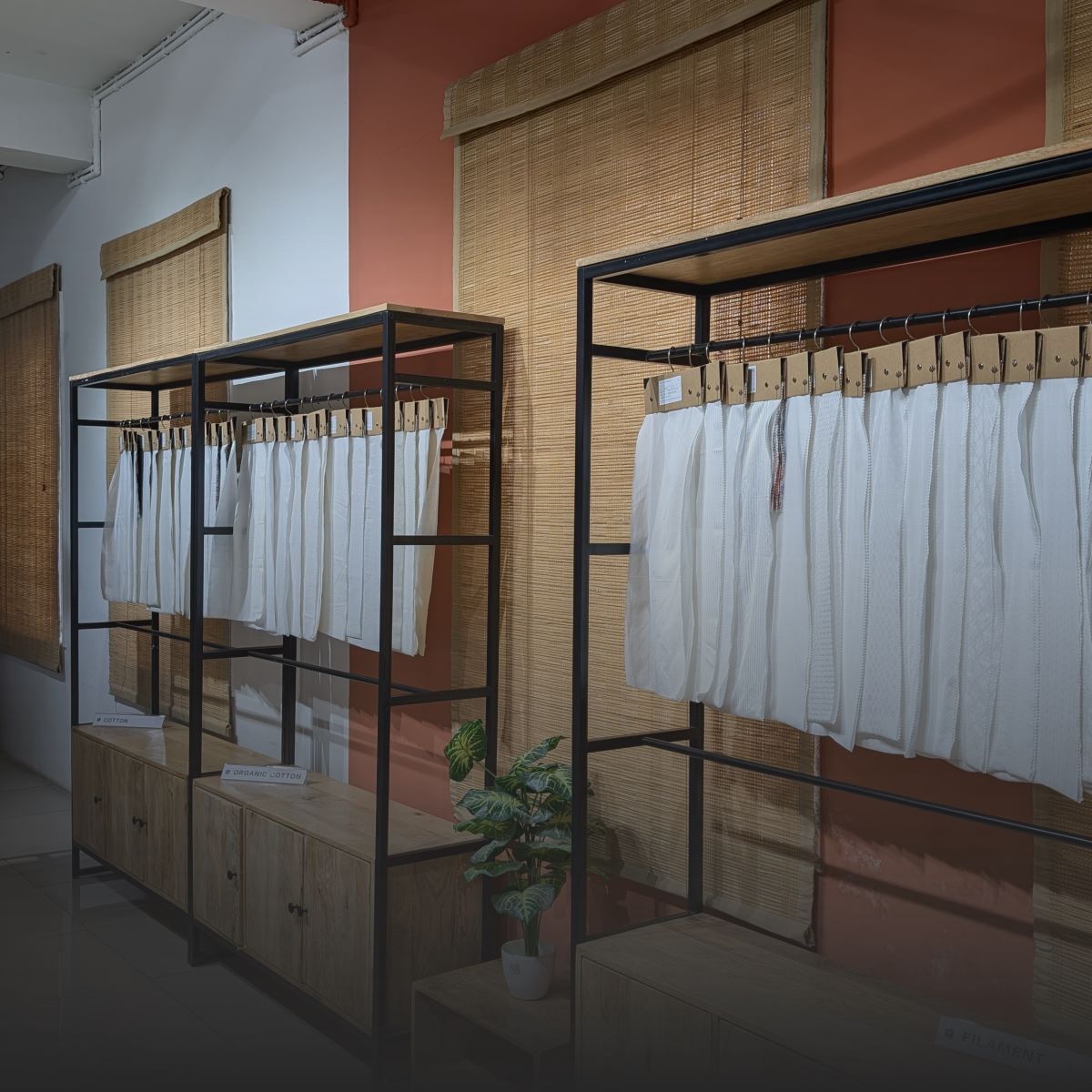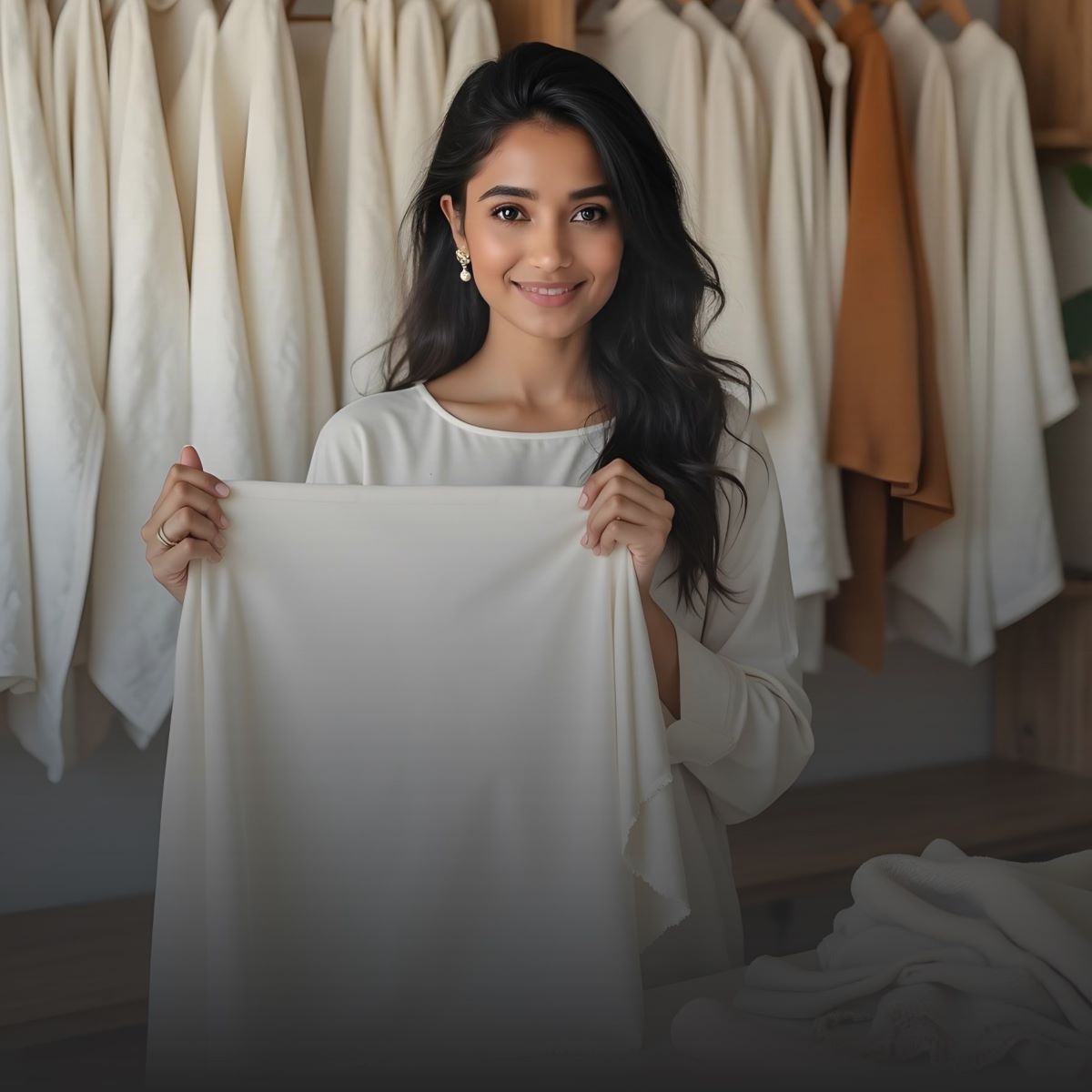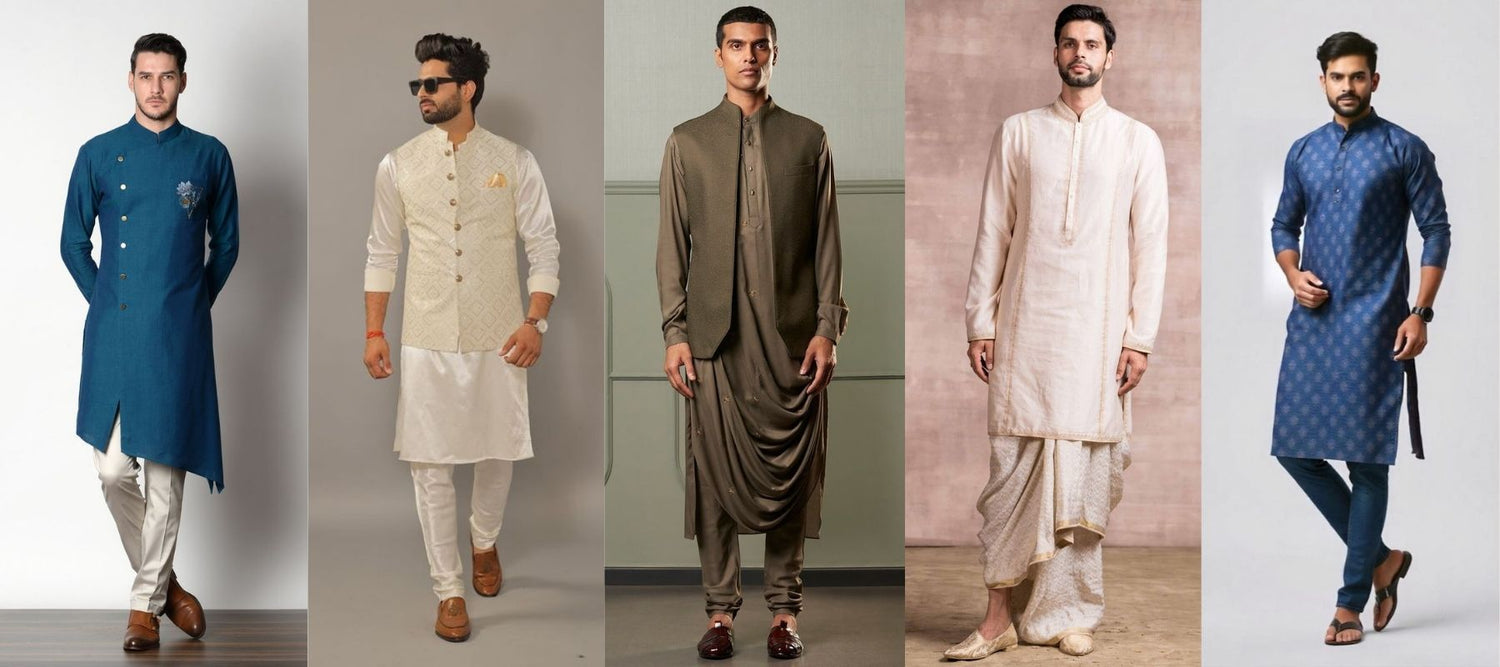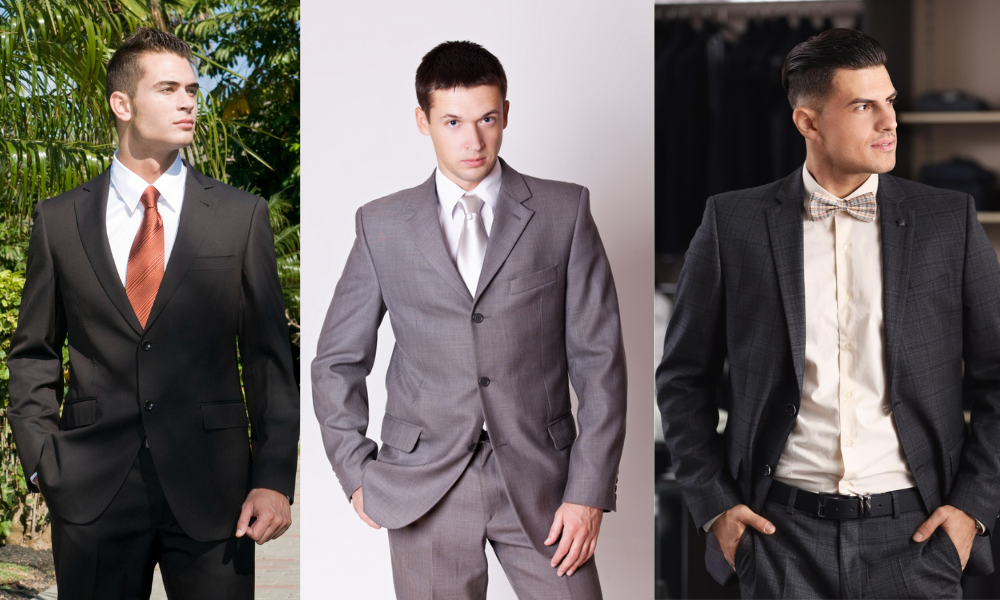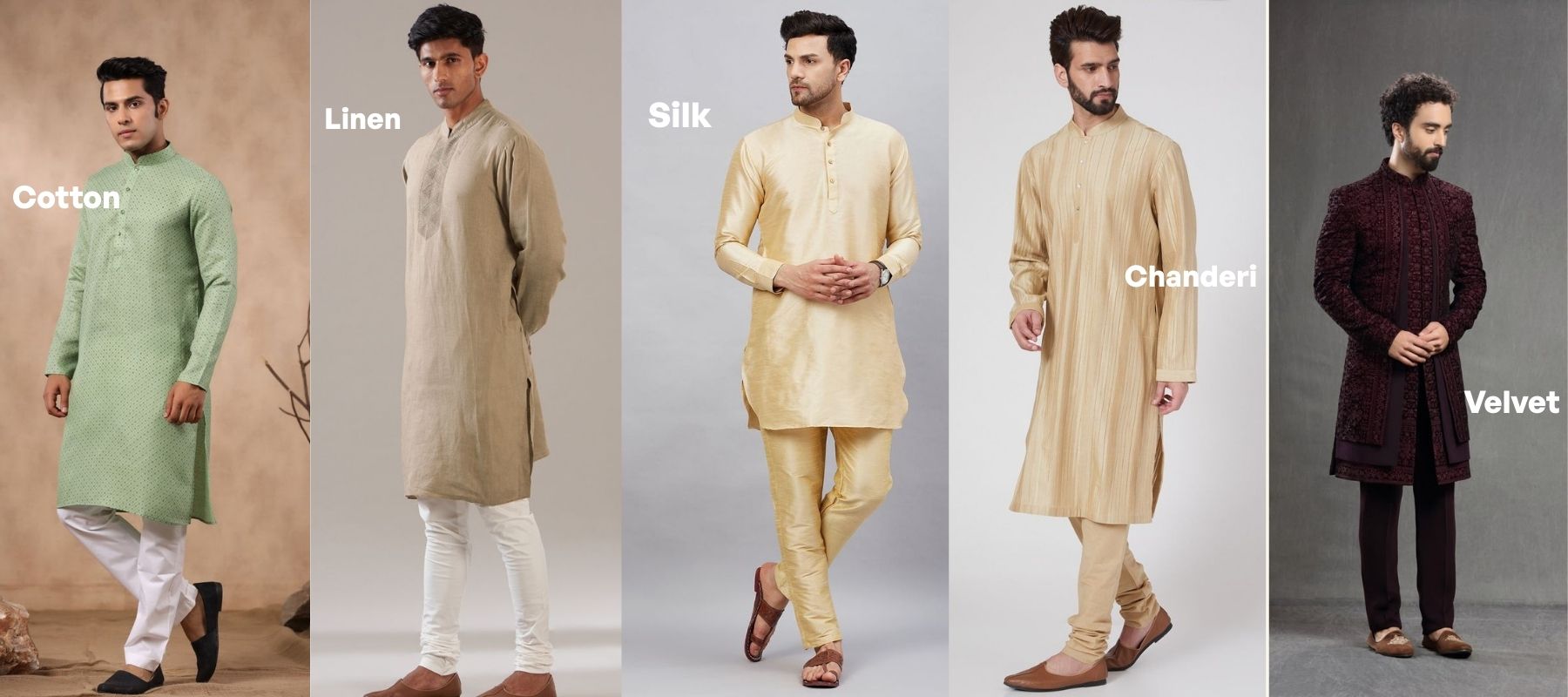Clothing is one of the three basic human needs. It protects the body and also reflects social values. In early times, men wore clothes mainly to guard against heat, cold, and rain. There was little focus on design or appearance.
Today, clothing also shows personal style and cultural identity. The kurta is a key part of traditional menswear. It is simple, comfortable, and suitable for many occasions.
Kurta has changed over time in shape, fabric, and cut. It remains a strong choice for both regular use and special events. Its variety in style and design helps every man find a suitable option.
Popular Types of Men’s Kurtas Based on Style and Design
Men’s kurtas are available in a wide range of styles. Each design brings a unique shape, fit and purpose. The right kurta style depends on body type, occasion and personal preference. Below are the most popular types of men’s kurtas based on style and design:
Straight Cut Kurta
The straight-cut kurta is one of the most common styles. It features a straight silhouette with slits on both sides. This design gives a clean and classic look. It suits most body types and works well for casual wear, office events, or religious functions. You can pair it with churidar, jeans, or pajamas.
A-Line Kurta
This kurta flares gently from the waist, forming an “A” shape. It offers more room around the hips, which makes it comfortable to wear for long hours. The A-line kurta adds a soft, flowing touch and is ideal for festive wear, family gatherings, or day functions. It pairs well with slim pants or churidar.
Asymmetric Kurta
An asymmetric kurta features an uneven hemline or neckline. This design gives a bold, fashion-forward look. It breaks the usual straight line and adds a modern twist. It is a good option for parties, weddings, or cultural events where you want to stand out. It goes well with fitted trousers or tapered bottoms.
High-Low Kurta
This style has a shorter front and a longer back. The high-low cut adds movement and shape to the garment. It looks stylish while staying simple. High-low kurtas suit young men and those who like contemporary styles. They are best worn with cigarette pants, jeans, or narrow pajamas.
Angrakha Kurta
The Angrakha kurta has overlapping panels tied with strings on the front. This design has roots in royal Indian clothing and brings a rich, ethnic feel. It is perfect for weddings, festivals, and traditional ceremonies. It usually comes in bright colors and can feature embroidery or print work.
Pathani Kurta
Pathani kurtas come from Afghan fashion. They have a loose fit, full sleeves, and a straight fall. They often include a shirt-style collar and buttoned placket. This style is best for a strong and masculine look. It is suitable for Eid, cultural programs, and formal gatherings. It pairs well with salwar or loose pajamas.
Cowl Kurta
The cowl kurta includes extra fabric that drapes or gathers around the front or sides. It creates a layered and structured look. This style gives a high-fashion feel while still being rooted in ethnic design. Cowl kurtas are ideal for reception parties, cocktail nights, and Indo-Western events. Wear them with fitted bottoms or dhoti pants for best effect.
Sherwani-Style Kurta
This kurta is long and ornate, inspired by the classic sherwani. It often features rich fabrics, embroidery, and buttons. Though lighter than a sherwani, it still looks grand and formal. This type is best for weddings, engagements, or festive occasions. It pairs well with churidar, jodhpuri pants, or formal bottoms.
Cape Kurta
Cape kurtas include an attached or separate cape layer that drapes over the shoulders. This adds volume and style to the outfit. Cape kurtas are perfect for fashion-conscious men who want to try something bold and modern. They work well for designer events, wedding functions, and festive evenings.
Fabrics and Materials for Men’s Kurta:
|
Fabric |
Description |
Best For |
Common Styles |
|
Light, breathable, and perfect for warm weather. Keeps you cool and dry. |
Casual wear, daily use, warm weather |
Straight cut, A-line, Pathani kurtas |
|
|
Airy, smooth texture, highly breathable, gives a sharp, clean look. |
Hot climates, semi-formal, casual events |
Straight cut, high-low designs |
|
|
Luxurious, smooth, and glossy finish, ideal for formal events. |
Formal events, weddings, receptions |
Sherwani, cowl kurtas with intricate embroidery |
|
|
A blend of silk and cotton, lightweight and glossy, perfect for festive wear. |
Festive wear, formal or semi-formal events |
Angrakha, high-low designs, delicate patterns |
|
|
Semi-synthetic fabric with a smooth texture and excellent drape, comfortable and stylish. |
Casual gatherings, evening events |
Asymmetric, cowl kurtas |
|
|
Traditional handwoven, eco-friendly fabric made from cotton, with a rustic yet refined look. |
Casual wear, cultural events, eco-conscious fashion |
Straight cut, Pathani kurtas |
|
|
Blended Fabrics |
Combination fabrics like cotton-silk, cotton-polyester, and viscose offer durability and comfort. Easier to maintain. |
Everyday wear, special occasions, modern styles |
Kurtas with embroidery or printed designs |
Men's Kurta Styling Tips for Different Occasions:

|
Occasion |
Style |
Fabric |
Pairing |
Footwear |
|
Casual Wear |
Straight cut or A-Line kurta |
Cotton or linen |
Jeans, chinos, slim-fit trousers, or pajama/dhoti |
Casual loafers or sandals |
|
Office & Workwear |
Straight cut or High-Low kurta |
Linen or cotton blends |
Tailored trousers or chinos in neutral colors |
Loafers or formal shoes |
|
Weddings & Formal Events |
Sherwani-style or Angrakha kurta |
Silk, Chanderi, or brocade |
Churidar or jodhpuri pants |
Juttis, mojaris, or formal shoes |
|
Festive Occasions |
High-Low or Asymmetric kurta |
Silk, Chanderi, or cotton-silk |
Churidar, pajama, or jeans; add a scarf/dupatta |
Mojaris, kolhapuris, or slip-on shoes |
|
Evening & Party Wear |
Cowl or Asymmetric kurta |
Rayon, silk, or fabric blends |
Fitted trousers or skinny jeans; add a jacket/vest |
Loafers, brogues, or trendy sneakers |
Type of Garment Suitable for Different Body Types:
|
Body Type |
Best Styles |
Fabric Choice |
Fit Tips |
|
Slim or Lean |
A-Line Kurtas, Cowl Kurtas, Angrakha Kurtas |
Linen, cotton, or blended fabrics |
Choose kurtas with a slight flare or draping for more shape. |
|
Tall and Thin |
Straight Cut, High-Low, Asymmetric Kurtas |
Cotton, rayon, or linen |
Avoid kurtas that are too long; keep the look sharp and neat. |
|
Short or Petite |
Short Straight Cut, Pathani Kurtas |
Light fabrics like cotton or rayon |
Make sure the kurta fits well and isn't too loose. |
|
Athletic or Muscular |
Straight Cut, Sherwani-style Kurtas |
Cotton blends, khadi |
Go for a tailored fit at the shoulders and chest but leave room at the waist. |
|
Larger or Broad |
A-Line Kurtas, Angrakha Kurtas, High-Low Styles |
Cotton, linen, khadi |
Pick kurtas that taper slightly at the waist for a balanced look. |
Trending Men’s Kurtas for the Season:

|
Kurta Style |
Description |
Best For |
|
High-Low Kurta |
Short front and longer back, giving a modern, sleek look while keeping the traditional kurta shape. |
Semi-formal gatherings, evening events, weddings |
|
Asymmetric Kurta |
Features an uneven hemline for a bold, contemporary style while staying true to traditional roots. |
Trendy parties, casual outings, cultural events |
|
Angrakha Kurta |
Overlapping panels tied with strings, offering a royal, elegant look. Perfect for formal occasions. |
Weddings, formal receptions, cultural celebrations |
|
Cowl Kurta |
Draped fabric with a layered design for a creative and unique style. |
Semi-formal gatherings, festive events, evening parties |
|
Sherwani-Style Kurta |
Long, ornate kurta for grand, formal occasions. A luxurious choice for high-end events. |
Weddings, receptions, grand formal events |
|
Cape Kurta |
A modern twist with a cape or overlay attached to the kurta, creating a stylish, dramatic look. |
Evening events, weddings, upscale parties |
Measurement Table According to Standard Size Chart:
Picking the right size for your kurta is important to make sure it fits well and feels comfortable. Use the size chart below, which follows standard sizes for men's kurtas. It will help you choose the best fit based on your body shape.
|
Size |
Chest (in inches) |
Waist (in inches) |
Hip (in inches) |
Shoulder (in inches) |
Kurta Length (in inches) |
|
S |
36 - 38 |
30 - 32 |
36 - 38 |
17 - 18 |
40 - 42 |
|
M |
39 - 41 |
33 - 35 |
39 - 41 |
18 - 19 |
42 - 44 |
|
L |
42 - 44 |
36 - 38 |
42 - 44 |
19 - 20 |
44 - 46 |
|
XL |
45 - 47 |
39 - 41 |
45 - 47 |
20 - 21 |
46 - 48 |
|
XXL |
48 - 50 |
42 - 44 |
48 - 50 |
21 - 22 |
48 - 50 |
How to Take Your Measurements:
-
Chest:
Measure around the fullest part of your chest, keeping the tape comfortably snug but not tight. This will give you the chest measurement for the kurta.
-
Waist:
Measure around your natural waistline, which is usually just above your belly button. Ensure the tape is not too tight.
-
Hip:
Measure around the fullest part of your hips, keeping the tape parallel to the ground. This is essential for a comfortable fit, especially if you're choosing a slightly longer kurta.
-
Shoulder:
Measure from the tip of one shoulder to the tip of the other shoulder across the back. This ensures that the kurta’s shoulder seams fit well.
-
Kurta Length:
Measure from the top of your shoulder down to the desired length of your kurta. Remember that kurta length varies depending on style (e.g., long kurta, short kurta). Keep in mind the occasion and comfort.
Conclusion
Choosing the right kurta is important for both looking good and feeling comfortable. This season, kurtas mix traditional and modern styles, so you can find one for any occasion. Whether it's a High-Low Kurta for casual outings or a Sherwani-style kurta for a wedding, there’s something for everyone. Don’t be afraid to try new styles, fabrics or designs; from the classic Angrakha Kurta to the trendy Cape Kurta, you can stay stylish and comfortable at the same time.
FAQs: Men’s Kurta Based on Style and Design
1. Which type of kurta is trending?
Currently, some of the most trending kurta styles include:
-
High-Low Kurta: This kurta is short in the front and longer at the back. It looks stylish and modern, perfect for parties or evening events.
-
Asymmetric Kurta: This style has an uneven cut at the bottom or neckline. It’s a trendy choice for casual outings, parties or cultural events.
-
Angrakha Kurta: This kurta has overlapping panels tied at the side. It looks royal and is great for weddings or formal events.
-
Cowl Kurta: This kurta has a draped, layered design. It gives a fashionable look and is ideal for festive or evening functions.
-
Sherwani-Style Kurta: A luxurious and ornate style for grand occasions like weddings and receptions, this kurta style is perfect for formal, high-end events.
-
Cape Kurta: A modern style with an attached cape, adding a dramatic flair. It's perfect for weddings, upscale parties and evening events.
2. How many types of men's kurta are there?
Here are some of the most common types:
-
Straight Cut Kurta: A classic, straight fit with slits on the sides.
-
A-Line Kurta: Flared from the waist, offering a more relaxed fit.
-
Asymmetric Kurta: Features an uneven hemline or neckline for a bold look.
-
High-Low Kurta: Shorter in the front and longer at the back, providing a modern look.
-
Angrakha Kurta: With overlapping panels and ties, often used for traditional events.
-
Pathani Kurta: A loose, straight-cut style with Afghan influences.
-
Cowl Kurta: Draped or ruched fabric for a stylish, layered effect.
-
Sherwani-Style Kurta: Long and ornate, ideal for formal occasions.
- Cape Kurta: Includes an attached cape for added volume and style.
Each kurta type can be further customized based on fabric, length, and fit to suit different occasions and body types.
3. Which kurta style suits me?
Choosing the right kurta depends on your body type and personal preferences:
-
Slim or Lean: A-Line, Cowl, or Angrakha kurtas work well as they add structure and shape.
-
Tall and Thin: Straight Cut, High-Low, or Asymmetric kurtas suit tall individuals, providing a sharp, neat look.
-
Short or Petite: A Short Straight Cut or Pathani kurta ensures a comfortable and well-fitted look without excess fabric.
-
Athletic or Muscular: Straight Cut or Sherwani-style kurtas fit best, with a tailored fit around the shoulders and chest, leaving room at the waist.
- Larger or Broad: A-Line, Angrakha, or High-Low kurtas offer a balanced look, tapering slightly at the waist for a flattering silhouette.
